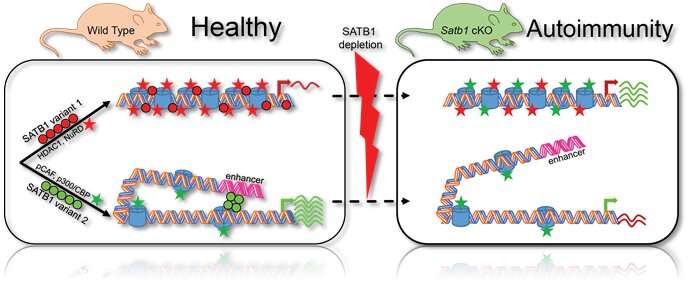Can the three-dimensional organization of the T cell genome regulate (auto)immunity?

The research team of Associate Professor Charalampos G. Spilianakis, an affiliated Professor at the Institute of Molecular Biology and Biotechnology of FORTH, has been working on determining whether the three-dimensional organization of the T cell genome can regulate (auto)immunity.
In this effort, the contribution of the laboratories of Christoforos Nikolaou (Department of Biology, University of Crete, IMBB-FORTH, BSRC Al. Fleming), Sören Franzenburg (Schleswing Holstein University Hospital, Kiel, Germany) and Dariusz Plewczynski (University of Warsaw, Poland) was instrumental.
The research team in Heraklion, Crete, created a T cell-specific knockout mouse that bears a deletion of the Satb1 gene. DNA is not found naked inside our cells but rather interacts with a multitude of proteins that package and regulate it in order to fit inside the nucleus of the eukaryotic cell.
The SATB1 protein binds to chromatin and regulates the three-dimensional organization of the T lymphocyte genome. This mouse model exhibits widespread autoimmunity identified by coat and skin problems, inflammation in multiple tissues and lymphoid organs (thymus and spleen).
Utilizing a great number of genomic approaches, the scientists involved were able to show that the SATB1 protein essentially creates gene networks in the three-dimensional space of the T lymphocyte, and that their expression is regulated with enormous precision.
Lack of the aforementioned protein, an organizer of the T lymphocyte chromatin, leads to deregulated expression of the immune-specific genes and therefore leads to the induction of extensive inflammation and autoimmunity.
The research team's next step, in the field of autoimmunity research, involves the design of highly specific small molecules to be tested for their ability to inhibit inflammation and autoimmunity, initially in a mouse model and later in humans.
The data has been published in Nature Communications.
More information: Tomas Zelenka et al, The 3D enhancer network of the developing T cell genome is shaped by SATB1, Nature Communications (2022). DOI: 10.1038/s41467-022-34345-y
Journal information: Nature Communications
Provided by Foundation for Research and Technology - Hellas



















